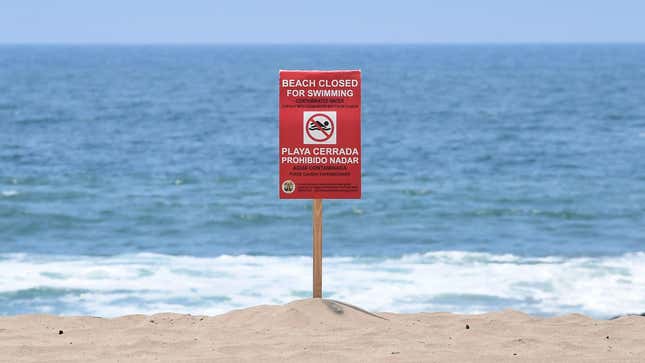
Stretches of beaches in Los Angeles are closed after 17 million gallons of untreated sewage spilled into the ocean following a mechanical failure at a water treatment plant Sunday.
Operators of the Hyperion Water Reclamation Plant, a sewage treatment plant located on Santa Monica Bay, said that they were forced to discharge untreated sewage Sunday through a pipe that dumped it a mile (1.6 kilometers) offshore and only 50 feet (15.2 meters) below the ocean’s surface. (The plant’s usual pipe discharges treated sewage five miles [8 kilometers] offshore and 190 feet [58 meters] deep into the ocean.) A Hyperion representative said it was the most sewage dumped out of that specific short pipe in a decade. The spill, according to the plant’s operators, was only 6% of the plant’s daily load of sewage.
The Los Angeles County public health department issued warnings telling residents to avoid swimming at certain beaches. It also said it had collected water samples to test for bacteria and beaches could open back up if tests come back clear. Preliminary tests taken Monday don’t show high levels of fecal bacteria, but beaches remain closed until more testing will be done.
“We have heard from many concerned folx that they were at the beaches on Sunday evening and Monday all day without any knowledge of the spill, or any ability to take precautions,” Heal the Bay, a conservation group, said in a Q&A posted on their website. “Bacteria and viruses in raw sewage are extremely dangerous to people and can carry a variety of diseases. Debris such as tampons and plastic trash, when released into the Bay, can harbor bacteria and can cause entanglement of wildlife, but it seems in this case those debris were successfully filtered out of the spill before it made it to the Bay.”
What happened at Hyperion that caused the huge sewage dump is a little unclear, plant operators said. On Sunday, screens in the treatment plants unexpectedly started clogging with a bunch of debris, blocking the entire treatment process. Plant operators said that they tried rerouting the sewage through a storm drain system to try and keep the treatment process going, but the sewage was simply too much and the plant’s overflow system was forced to discharge the 17 million gallons through the short pipe over an eight-hour period.
The Hyperion plant—which has been around since, unbelievably, 1894—is Los Angeles’ biggest treatment plant. Each day, the plant uses that 5-mile pipe to dump 260 million gallons of treated wastewater, which is enough to fill the Rose Bowl 2.5 times over, deep into the Pacific Ocean.
Even though the untreated sewage that spilled this week is a public health hazard, there’s a real debate to be had over whether or not the treated water could be useful to a state in an unending, historic drought. Last August, a Los Angeles court mandated that California’s Water Resources Control Board needs to evaluate whether it is “wasteful” and “unreasonable” to dump all that water in the ocean when it could be used elsewhere. City leaders have made wastewater recycling a priority, with the goal of drawing 70% of Los Angeles’ drinking water from treated wastewater by 2035. And with a devastating drought sapping reservoirs across the state (and the West for that matter), addressing the water crisis can’t come soon enough. Even if the solution sounds a little gross.